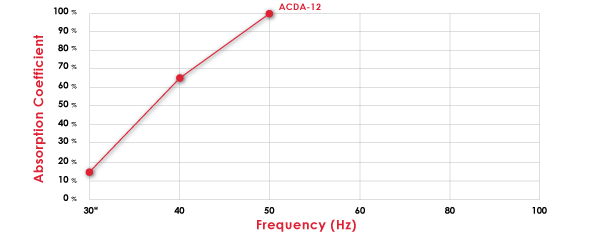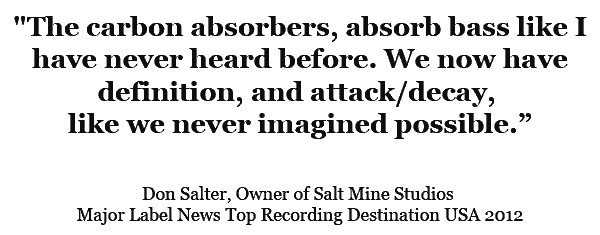Sound absorption is a misunderstood technology. It always gets credit or has claims that it can do much more than it really can. You know this because of the laws of physics. For example, there are many manufacturer claims that this foam or sound absorption product absorbs, low frequency energy, when we know from the laws of physics, that it just simply can not do that. Foam in particular, gets a bad rap because it has been called and used extensively in so called and labeled “bass traps”. This is not accurate on two levels.
First, bass traps do not trap bass. There is no way that a foam wedge can “trap” anything other than dust, especially when the wave of energy it needs to “trap” is 37′ long and with an attitude. It will not be trapped by anything, even a concrete wall or walls. Secondly, you would need 11′ of foam just to absorb a 100 Hz. wavelength. How is 12″ of foam shaped in the form of a wedge going to deal with a 37′ wave. It cannot and any claims made by acoustical product manufacturers that it can are simply a lie.
TWO MAIN AREAS OF SOUND ABSORPTION
There are two main areas of sound absorption technologies that we must examine. There are middle and high frequency sound absorption products and there are low frequency sound absorption products. Middle and high frequencies are > 100 Hz. There are many manufacturers with products in these frequency areas and bands because most materials needed to absorb energy within these frequency bands are not thick or dense materials. Open celled acoustic foam is an example of economical sound absorbing material that is available in many different thicknesses. However, most manufacturers try to absorb 100 % of all frequencies above 100 Hz. with their sound absorbing technologies. Changing sound energy to heat through absorption in order to manage it basically destroys precious sound energy. We do not need to destroy our sound energy in order to manage within our rooms.
FOAM TECHNOLOGY
It is better to design a foam technology that has more absorption above 125 Hz. and then transitions slowly up through and past 500 Hz. where every foam absorbs at 100%. This greater amount of absorption beginning at 125 Hz. and rising in a much smoother and more even rate and level produces a remarkable difference in your mid range and vocals. Vocals become more defined and separated and this increased definition results in vocals and mid ranges that are clearer and more defined. With clearer and more defined mid range and vocals, you can achieve a greater emotional connection to the music.
LOW FREQUENCY
Low frequency is defined as all frequencies below 100 cycles. The issue with sound absorption claims by manufacturers is that most just use their middle and high frequency absorbers add some more thickness and call them “bass traps”. They do not use new research and development to create a real low frequency absorber. They just “expand” there middle and high frequency technology and call it a low frequency absorber. It is almost like they were sitting around the office one day and were looking at their existing product line. They noticed that they did not have a “bass trap”, so in order to fill a notch for marketing a product was created out of existing technologies. Real low frequency absorption can only be achieved using diaphragmatic absorption or a tuned cavity called a Helmholtz resonator.
HELMHOLTZ RESONATOR
A tuned resonator like a Helmholtz resonator is a low frequency tube or cabinet that has an opening in the top of the unit. The unit is sealed except for the slit which is an opening for sound energy to enter through, move around within the chamber of the resonator and undergo a change to heat energy. The opening in the resonator, the depth of the resonator, internal volume, and resonator cabinet density all contribute to the resonators absorption rate and level. They are not easy to design and the opening dimensions become critical in the level of absorption that can be achieved. A better approach is to use a technology called diaphragmatic absorption.
DIAPHRAGMATIC ABSORPTION
Diaphragmatic absorption is a three part technology where the overall performance of the technology is greater than the sum of its parts. We have taken the time tested and proven method of low frequency absorption and taken its 3 main component parts and drastically improved each parts performance. The dual front wall is two walls not one as in most diaphragmatic absorbers. The two walls are of different materials and densities that were chosen to move in sympathy with each other. Their job is to slow the wave down.
The cabinet is designed with 7 different layers of materials and is assembled in such a manner to reduce vibrations at the cabinet level, so the front two walls are the only walls that move in response to sound pressure. The internal cabinet fill is our activated carbon technology that absorbs a lot of energy in a small amount of area. One gram of activated carbon has over 2,000 square meters of surface area to absorb energy in. Take all of these improvements in an already strong and powerful low frequency technology and you have a sound absorber that is the most powerful one in the marketplace today as independently tested and verified by the world famous Riverbank Acoustical Labs – you can see our test results with them here.
FEATURES AND BENEFITS
With our acoustic foam technology, for middle and high frequency absorption, you receive three different thicknesses which will allow you to absorb reflections within your room using just the right rate and level of absorption for the acoustic goals you require, so your middle range frequencies and especially your vocals have clarity and definition.
That red curve is the difference between OK and OUTSTANDING vocals! Which would you rather have?
Just look at the difference between us and the competition!
This foam will make you hear music like you never thought possible!
With our foam technology, you can purchase just our acoustic foam or our acoustic panels which house our foam in a wood cabinet. If you are skilled in wood working, you can also build your own wood foam cabinet, so you can use this technology regardless of your budget.
With our diaphragmatic absorption technology you get a low frequency absorber that goes lower and absorbs at much higher rates than any existing low frequency absorber currently in the marketplace. This will enable you to have a much greater attack and decay definition which is what low frequency management is all about. With greater attack and decay definition, you will hear each lower frequency note that is produced by drums or a bass guitar in the way the artist and engineer intended.
ACDA-12 Absorption Performance Chart – The ACDA 12 absorbs 100% at 50 Hz.
and does a great job all the way down to 30 Hz.!
With our diaphragmatic absorber, you get over 65 lbs. of activated carbon in each unit. Activated carbon has over 2,000 sq.m. per gram of sound absorption surface area which contributes directly to the unprecedented amounts of low frequency absorption in each unit.
With our diaphragmatic absorption, you receive a technology that has been time tested and proven in many years of professional recording studio builds, along with structural changes to cabinet design and density that enables this proven technology to perform even better.
Testimonial from Joe Salvatto, Recording Studio Designer and owner of Salvatto Sound, New York City. Clients include 50 Cent, Billy Joel and many more. Here he discusses the Acoustic Fields Activated Carbon low frequency absorbers.
“The effectiveness of the box is exponential, the larger the room, the more boxes you need. But in the end the result is nothing short of amazing! Once you introduce the absorbers into the room, the effects are noticeable immediately.
“It has the capabilities to absorb frequencies down to the 30 cycle range. Everything Dennis said it would do, its done and then some.”
“This device has added a paint brush to my box that I never would have thought I’d be able to have in this small of an enclosure. I’ll be using them from now on and I’m sure once you get a chance to use them, so will you.”





